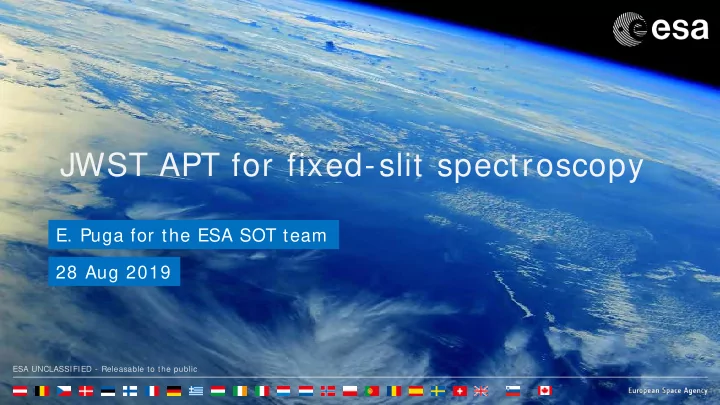

JWST APT for fixed-slit spectroscopy E. Puga for the ESA SOT team 28 Aug 2019 ESA UNCLASSIFIED - Releasable to the public
Outline for me § APT fixed slit spectroscopy templates § Target acquisition (explain tradeoffs) § Science aperture selection § Wavelength coverage and gaps § spectral resolution § sensitivities § Subarray detector configurations + detector readout pattern § Dither pattern (trade offs) + background subtraction ESA UNCLASSIFIED – Releasable to the public
APT Fixed-slit spectroscopy templates § Fixed Slits in NIRSpec and MIRI are designed to provide high contrast single object spectroscopy and bright object time series spectroscopy. § When creating a new observation, the user defines the APT template § MIRI § NIRSpec § APT fixed-slit spectroscopy templates are divided into four sections: 1. Generic information 2. Observation information 3. Target acquisition parameters 4. Science parameters ESA UNCLASSIFIED – Releasable to the public
APT Fixed slit spectroscopy template § NIRSpec Generic information Observation information ESA UNCLASSIFIED – Releasable to the public
APT Fixed slit spectroscopy template § NIRSpec ESA UNCLASSIFIED – Releasable to the public
APT Fixed slit spectroscopy template § MIRI § Dedicated observations for source/ background defined at Target Level ESA UNCLASSIFIED – Releasable to the public
NIRSpec ETC Calculation for Target Acquisition WATA New v1.2 ESA UNCLASSIFIED – Releasable to the public
Target acquisition NI RSpec TA m ethods: MI RI TA procedures: § W ATA ( default) using science or offset target § LRS slit mode centred in S1600A1. 8-15 minutes. Expected § LRS slitless mode accuracy: 20 mas. § Use of science or offset target, at distance § MSATA uses a catalogue reference stars (may < 60 arcsecond require pre-imaging). It is specified at the visit level § TA is therefore not mandatory in the LRS APT of the observation, not directly at the observation template; however, for observations of point or template. 24-30 minutes. Expected accuracy: 20 – compact sources it is highly recommended. 60 mas. § NONE is not recommended for FS. The resulting pointing accuracy will be that delivered by the GS acquisition at the start of the Observation. For § https://jwst-docs.stsci.edu/mid-infrared-instrument/miri-observing- reference, the absolute pointing accuracy of JWST for strategies/miri-generic-recommended- NIRSpecis expected to be ~ 0.34 arcsecond strategies#MIRIGenericRecommendedStrategies- MIRI_TA_BPTargetacquisitionbestpractices § https://jwst-docs.stsci.edu/near-infrared-spectrograph/nirspec- § https://jwst-docs.stsci.edu/mid-infrared-instrument/miri-observing- observing-strategies/nirspec-target-acquisition-recommended-strategies strategies/miri-lrs-recommended- strategies#MIRILRSRecommendedStrategies- TargetAcquisitionConsiderations ESA UNCLASSIFIED – Releasable to the public
Target Acquisition strategies and parameters NI RSpec: MI RI : § MSATA: § Filters: F560W, F1000W, F1500W, and FND § § Filters: F110W, F140X, CLEAR Subarray configuration: N/ A, controlled by the subarray science parameter § Subarray configuration: FULL § Readout patterns: FAST(default), FASTGRPAVG § Readout pattern: NRS, NRSRAPID, § Groups are selectable, integrations is always 1 NRSRAPIDD1, NRSRAPIDD2 § WATA: § Filters: F110W, F140X, CLEAR § Subarray configurations: SUB32, SUB2038, FULL § Readout patterns: NRS, NRSRAPID § Groups/ Integrations are fixed § TA readout mode switch with respect to science parameters costs extra time. The user should always refer to the ETC for signal-to-noise calculations. ESA UNCLASSIFIED – Releasable to the public
NIRSpec Science apertures ESA UNCLASSIFIED – Releasable to the public
NIRSpec Science apertures § S200A1, S400A1, S1600A1 with slit sizes 0.2 x 3.2, 0.4 x 3.65 and 1.6 x 1.6 arcsec, respectively § S200A1 and S200A2 in slit combination to cover the gap, that doubles the exposure time § 8 filter-disperser combinations https://jwst-docs.stsci.edu/near-infrared-spectrograph/nirspec-observing-modes/nirspec-fixed-slits- spectroscopy/nirspec-fs-wavelength-ranges-and-gaps ESA UNCLASSIFIED – Releasable to the public
MIRI Science apertures § Low Resolution Spectrometer (R~ 100) § Prime spectrometer for observations of faint targets at 5 – 12 µm § Prism in imager filter wheel § 0.5 x 4.6 arcsec slit or slitless (more stable for high precision spectro-photometry, but less sensitive since no background masking) § Saturation limits (point sources @7.5 µm): slit – 100.3 mJy, slitless – 1324 mJy ESA UNCLASSIFIED – Releasable to the public
Subarray configurations and Readout patterns NI RSpec: MI RI : § Subarray: § Subarray: § FULL § FULL (slit) § Tailored subarrays per individual slit: SUBS200A1, § SLITLESSPRISM (slitless) SUBS200A2, SUBS200B1, SUBS400A1 § Readout patterns: § S1600 subarrays: SUB2048, SUB1024A, § SLOW (N samples = 9, t 1 = 23.890 s) SUB1024B, SUB512 § FAST (N samples = 1, t 1 = 2.775 s) § ALLSLITS (S200A1 and S200A2 combined, but not only) https://jwst-docs.stsci.edu/near-infrared-spectrograph/nirspec-observing- strategies/nirspec-detector-recommended-strategies ESA UNCLASSIFIED – Releasable to the public
FS Nods and dithers NI RSpec: § APT Primary dither positions = = nod along the slit used to subtract background flux § Sub-pixel dithers used to mitigate detector effects, help remove cosmic rays, and particularly improve spectral and/ or spatial sampling § https://jwst-docs.stsci.edu/near-infrared-spectrograph/nirspec-observing-strategies/nirspec-background-recommended-strategies § https://jwst-docs.stsci.edu/near-infrared-spectrograph/nirspec-observing-strategies/nirspec-dithering-recommended-strategies ESA UNCLASSIFIED – Releasable to the public
FS Nods and dithers MI RI : § ALONG SLIT NOD (default for compact sources) § MAPPING customizable offsets along-slit and across-slit. Extended sources mapping can also be produced by mosaicing. § In slitless mode, dithering is not allowed § https://jwst-docs.stsci.edu/mid-infrared-instrument/miri-observing-strategies/miri-lrs-recommended-strategies#MIRILRSRecommendedStrategies- ditherDithering ESA UNCLASSIFIED – Releasable to the public
APT Fixed slit spectroscopy template § Other tabs: Mosaic properties, Special Requirements, Comments tabs ESA UNCLASSIFIED – Releasable to the public
APT FS Summary § For v27.2, substantial effort has been put into improving ETC-APT handshake § Target Acquisition is currently more complete and setting its parameters requires some decisions and ETC dedicated calculations. § FS Science parameters: § Explore capabilities. Starting point: JWST Pocket Guide § Consider tradeoffs regarding aperture selection, subarray detector configurations and detector readout patterns and especially background subtraction. ESA UNCLASSIFIED – Releasable to the public
Recommend
More recommend